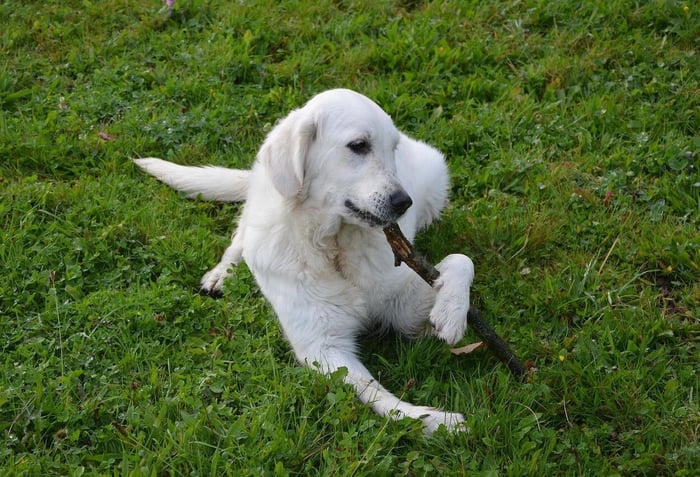We've all seen it: the classic moment when our four-legged companion tilts their head, a curious or intrigued expression on their face that never fails to soften our hearts. It's an Instagrammable stance that frequently leaves us thinking, "Why on earth did they do that?" Is it a reaction to a new sound, a quirky method of demonstrating that they're paying attention, or something totally different?
Dogs, you see, communicate differently than humans. While they may not use words to communicate, they have a complex tapestry of body language, gestures, and sounds. One such remarkable behavior is the head tilt, an almost ubiquitous "doggy" motion. Let's go on an adventure to understand this charming habit, exploring the facts, hypotheses, and sheer beauty behind those tilted puppy eyes.
Understanding Canine Behavior
Dogs have been our trusty companions for thousands of years, evolving with us as pals, confidantes, and family members, not only as hunters or guardians. It's not surprising that these creatures have evolved ways to 'speak' to us even in the lack of a common language.
While a dog's bark or whimper is an obvious mode of communication, it's in their silent body language where the real stories unfold. From the wagging of their tail to the position of their ears and the arch of their back, dogs constantly send signals about their feelings, intentions, and perceptions.
For instance, a raised tail often showcases confidence, while a tucked one might hint at fear or submission. Likewise, a dog leaning forward might be curious or confrontational, while one leaning back could be anxious or unsure.
Among the myriad expressions and postures our dogs offer, the head tilt is perhaps the most captivating. It's not merely a cute gesture; it's a multifaceted signal. It can denote anything from intrigue to confusion, or even just a response to a certain tone or word they've learned to associate with fun activities like a walk or treat.

Why Dogs Tilt Their Heads
If you’ve ever noticed your dog tilting its head when you speak or make a sound, you’re witnessing one of their most endearing behaviors. While this might seem like a simple reaction, head tilting in dogs can indicate various possible causes, ranging from curiosity to an underlying health issue. Here's why most dogs exhibit this behavior and what you need to know.
Listening to Sounds and Improving Hearing
Dogs have an incredible sense of hearing. When your dog tilts its head, it may be trying to better position its external ear canal to detect the source and direction of a sound. This adjustment helps them interpret sounds more accurately, whether it’s your voice, a rustling treat bag, or other noises in their environment. For breeds with longer muzzles, the tilt also helps them see past their nose, improving their ability to focus on you or their surroundings.
Understanding the Vestibular System
A dog’s vestibular system, located in the middle and inner ear, plays a crucial role in maintaining balance and spatial awareness. If your dog shows a persistent head tilt accompanied by other symptoms like dizziness, loss of balance, or vomiting, it might indicate a problem with their vestibular system, such as peripheral vestibular disease or central vestibular disease.
Common Health Concerns Behind Head Tilting
While an occasional head tilt is typically harmless, certain signs could point to more serious underlying causes. Some of the most common causes include:
Ear Infections: Conditions like otitis interna (inflammation of the inner ear) or infections in the middle ear can cause head tilting in dogs, along with pain, redness, or discharge.
Vestibular Diseases: Idiopathic vestibular disease—often seen in older dogs—affects their balance and can cause sudden tilting of the head. Though alarming, with supportive care and prompt treatment, most dogs recover fully.
Head Trauma: Injuries to the brain or inner ear from an accident or fall can result in a dog’s head tilting and require immediate attention.
Tumors or Neurological Problems: Rare but possible causes, such as growths or neurological issues, might also disrupt a dog’s balance.
When to See a Veterinarian
If your dog’s head tilting becomes persistent, is accompanied by other signs like vomiting, difficulty walking, or changes in behavior, it’s essential to consult a veterinarian immediately. Early diagnosis and prompt treatment can address issues such as ear infections, inflammation, or more severe conditions like a stroke or tumor.
Positive Reinforcement and Recovery
For cases that don’t indicate serious health concerns, positive reinforcement can encourage healthy behavior. Dogs often respond to your tone and words, so rewarding them during moments of engagement—like when they cock their head to hear your voice—strengthens your bond. If treatment is needed, most dogs with proper care, such as antibiotics for infections or supportive care for vestibular diseases, make a full recovery.

What Science Says About the Tilt
The beautiful tilt of a dog's head has grabbed the hearts of pet owners as well as scientists and experts. While witnessing our pets in their natural settings (our homes) is instructive, it's also important to examine what controlled studies and research have to say about this behavior.
Mechanics of the Brain and Sound Localization
Recent research has looked into the anatomy and physiology of a dog's inner ear. These complex structures aid our dogs in determining the source of a sound. Dogs may alter the location of their ears to better pinpoint noises in their environment by tilting their heads, a capability critical for their predecessors in the wild.
Human-Dog Bonding and Emotional Resonance
The emotional connection behind the head tilt has also been studied. Dogs, as skilled observers, frequently mimic or respond to human emotions. According to one study, dogs are more likely to tilt their heads when they hear familiar or emotionally charged noises, such as their owner's voice or the sound of a toy they recognize.
Breed Specifics and Genetic Proclivity
Surprisingly, not all dogs tilt their heads at the same rate. According to research, breeds with larger muzzles may be more prone to this behavior, lending credence to the previously cited visual argument. However, some breeds may have developed the tilt as a heightened kind of sensory perception as a result of their genetic history and roles (such as herding or hunting).
Is Head Tilting Ever a Cause for Concern?
As endearing as our canine companions are when they showcase that iconic head tilt, there are moments when this gesture might prompt a furrowed brow of concern among pet owners. While the tilt is generally a sign of curiosity or engagement, it's crucial to be aware of when it might indicate something more serious.
Frequency and Duration: Not Just a Fleeting Gesture
A sporadic head tilt, especially in response to sounds or new stimuli, is generally harmless. However, if your dog maintains a tilted position for extended periods without an apparent trigger, it might be time to delve deeper. Persistent tilting could indicate discomfort or an underlying issue that warrants attention.
Accompanied Symptoms: Reading Between the Lines
While the tilt alone can sometimes be a cause for concern, it's essential to observe any other accompanying symptoms. Signs like loss of balance, difficulty walking, eye twitching, or even nausea can be indicative of more severe conditions, such as vestibular disorders. Being alert to these signs ensures timely intervention.
Changes in Behavior: Beyond the Tilt
A dog that suddenly becomes more reserved, loses interest in play, or shows changes in eating habits—along with frequent head tilting—might be signaling distress or discomfort. It's crucial to connect the dots between the tilt and other behavioral shifts to get a comprehensive understanding of your pet's well-being.
Trauma and Past Incidents: Connecting the Past
If your pet recently had a fall, accident, or any other traumatic experience, even if it seemed minor, a resulting head tilt should be addressed promptly. What might seem like a simple bump could have deeper repercussions that only manifest subtly through behaviors like tilting.
Conclusion
In the vast tapestry of canine behaviors, the head tilt stands out as a poignant blend of curiosity, engagement, and emotion. From the playful puppy trying to decipher a new sound to the wise old dog looking at us with years of trust and understanding, each tilt tells a tale of its own.
But like many aspects of pet ownership, there's a balance to strike. While we relish in these endearing moments, celebrating each tilt as a testament to our deep bond, it's equally our duty to ensure the well-being of our four-legged family members. Recognizing the line between simple curiosity and potential distress is crucial. It reminds us that with the joys of companionship come the responsibilities of guardianship.












